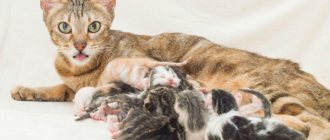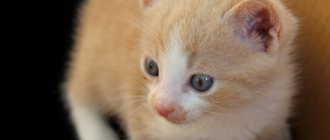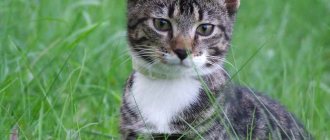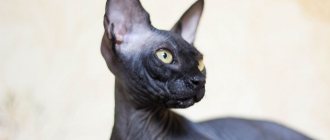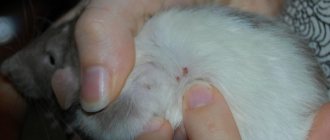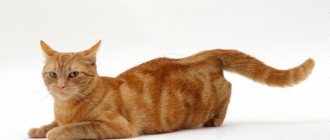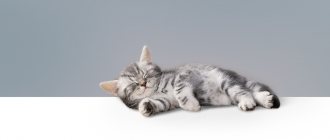What is needed for childbirth
It is necessary to prepare everything for childbirth in advance. Here is a complete list of what may be needed in case of emergency, although it is quite possible that nothing else will be needed besides the box, because almost every cat gives birth on its own.
- Soft and cozy box.
- Sterile gloves.
- A syringe to remove discharge from the kitten's nose and mouth.
- Clean cloths and towel. You can use toilet paper.
- Scissors.
- Antiseptic drug.
- Telephone for urgent calls to the doctor in case of complications in a giving birth cat.
- You may also need a cat milk replacer.
How many kittens can a cat give birth to?
Cats reach sexual maturity at approximately 8-9 months. And before the age of 1 year, she is already able to become pregnant and bear offspring. However, experienced breeders understand that this is quite early, and consider such births to be risk factors, since the body is still too young.
Note to the owner! It is not recommended to breed domestic cats under 1 year of age, although in the case of backyard dwellers we cannot in any way influence this fact. It is advisable to wait until the cat is one and a half years old, when the cat’s body is stronger and ready to bear healthy offspring.
Primiparous cats usually give birth to a small litter: 1-3 babies. This is explained by the reproductive system not yet fully formed. Overmature felines also give birth to few kittens, since their reproductive function is already fading. Cats, healthy, well-groomed, in their prime, usually give birth to up to 6 kittens.
Nature has endowed a cat with only 8 nipples. This means that she can feed no more than 8 cubs at a time. But sometimes there are exceptions: cases have been recorded when a cat gave birth to more than 10 or even 12 kittens.
The maximum number that a domestic cat can give birth is difficult to determine. Some breeders believe that this depends on the number of nipples the cat has. If you count them and subtract the number 2 from the sum, the resulting number will indicate the maximum number of kittens that a cat can have. However, this method of determination cannot be called absolutely reliable, although it can be adopted for yourself.
Physiologically, the number of offspring is determined by the number of attachment sites of fertilized eggs to the walls of the uterus, which in cats consists of 2 horns. This is why young and older females give birth to fewer kittens than cats at optimal reproductive age.
It has been proven that street stray cats produce more offspring than domestic cats. Experts explain this fact by relaxation of the genetic apparatus in cats living in comfortable conditions. Representatives of the streets and courtyards are forced to leave behind numerous offspring in order to preserve the cat family.
When is the best time to breed a cat for the first time?
When determining the optimal time for the first pregnancy, breeders and veterinarians focus on the beginning of the cycle, planning mating for the 3rd heat. The first 2 periods of sexual activity are ignored. At this time, you cannot use hormonal drugs that suppress libido and suppress estrus - they have a detrimental effect not only on the reproductive system, but also on other systems of the body.
It is advisable that the first date with a cat takes place before the age of one and a half years, otherwise difficulties may occur during mating - the female may show aggression and not allow the male to approach her. By the time of the meeting, the cat should be completely healthy. In this case, the risks of complications during pregnancy and childbirth are minimized.
How long does a cat's pregnancy last?
Let's figure out how many months or days a cat stays pregnant.
A cat's gestation period can vary up to 9 weeks. This is approximately 2 months. It is noteworthy that short-haired individuals usually bear babies for 58-68 days, long-haired ones - 63-72.
The course of pregnancy also depends on the number of kittens: if there are fewer than five, the “maternity leave” may be delayed; if there are more, the cat may give birth earlier.
The normal delay in labor is no more than a week. It is more dangerous if kittens are born a week ahead of schedule - they may die.
The characteristics of the Scottish Straight breed are described in the article below the picture.
You will learn about what you need to know to keep a Maremmo-Abruzzese Shepherd Dog at this link.
Yorkshire Terrier - hunter or glamorous thing:
What determines the number of kittens?
The number of kittens in a litter is influenced by many factors:
- Firstly, this is the age of the cat. Firstborns most often give birth to a maximum of three cubs. Fertility also decreases in fairly mature females. After the age of seven, a cat gives birth to fewer babies than before the age of 6-7 years. The peak of large families (from 4 to 12 babies per litter) occurs between the ages of 3 and 6 years.
- Heredity also affects possible fertility. If the cat's ancestral ancestors produced numerous offspring, then most likely your animal will be fertile.
- The reason for the small number of kittens is often a hormonal imbalance, which leads to a decrease in the synthesis of eggs ready for fertilization.
- Breed also matters. A trend has been noticed: a purebred cat gives birth to fewer kittens than a mongrel yard animal, and rarely gives birth to more than 5 babies at a time.
- Obesity or, conversely, exhaustion reduces the possible number of offspring.
- A lot also depends on nutrition. If a cat does not get enough protein, taurine, vitamins and minerals, she may develop nutritional infertility (infertility). A meager diet leads to the fact that the animal’s defensive reaction to the lack of certain substances is the fertilization of a small number of eggs.
- Chronic inflammatory processes of the reproductive system negatively affect the cat's reproductive function and can cause the cat to become infertile.
- Another reason for the birth of a minimum number of kittens can be long-term and indiscriminate use of hormonal drugs, such as Counter-Sex, Sex-Barrier. Hormone-based contraceptives seriously undermine the reproductive function of the animal, causing hormonal stress in the body. And this, in turn, leads to the birth of a maximum of 1-2 babies in the litter.
The male also contributes to the number of offspring. During sexual intercourse, a temperamental cat releases a larger number of eggs for fertilization. In addition, the quality of sperm also matters.
Thus, the number of kittens in a litter is influenced by a variety of factors, and it is not always possible to take them into account.
When do you need veterinary help?
In most cases, the cat copes with the birth of kittens on her own. But there are times when the help of a loving owner is extremely necessary. Sometimes, due to fatigue and pain, a cat can “squeeze” a cub that is only halfway out. Most often, this happens if the kitten walks forward with its hind legs.
Such situations require immediate intervention. The easiest way to help is to grab the cat by the scruff of the neck so that it stands upright on its hind legs.
By switching to a new stimulus, the woman in labor will relax the vaginal muscles and the kitten will be born. If this does not help, then more radical measures should be taken. You need to carefully take the kitten with a gauze cloth (a clean cloth or a gynecological glove) and pull it out with light, rocking movements. This should be done at those moments when the cat begins to struggle.
Normal birth in British cats does not require specialist intervention. However, owners should observe how the cat behaves after giving birth. If certain symptoms occur, you should immediately call your nearest veterinary clinic.
We suggest you read: Fleas on a cat - how to identify and get rid of them
• labor does not begin more than 70 days after conception;
• there are signs of fever and increased temperature in cats before giving birth;
• fever in cats after birth;
• the appearance of bright red discharge from the vagina, lasting more than 10 minutes;
• unpleasant and pungent odor from the vagina;
• contractions in cats without continuation of labor for a long time (more than an hour);
• restless behavior of the cat after the termination of labor.
How to determine the number of future kittens?
Some breeders claim that the exact number of future cubs is indicated by the number of milk nipples in the mother. However, the reliability of this method has not been proven.
Veterinarians sometimes palpate a cat’s belly to determine the size of the litter, but this technique cannot be called safe for the health of the animal. Palpation is most often carried out at 20 - 21 days or 49 - 55 days after mating. The timing is due to the fact that after the 21st day the uterus fills with amniotic fluid, which complicates diagnosis.
Ultrasound examination of the uterus is considered the safest and most informative method. An ultrasound can be performed to determine the number of future kittens starting from the 21st day after mating. By this period of pregnancy, you can determine the number of babies in the mother’s womb and listen to their heartbeat.
A serious and responsible breeder is always puzzled by the question of the number of kittens in a cat’s litter. This information allows him to competently approach the birth process and resolve the issue of selling young animals in advance. Understanding the causes and factors influencing a cat’s fertility and knowledge in the field of genetics will allow you to choose the right inseminator for your mustachioed pet and follow the rules of feeding and keeping her during pregnancy.
If the owner asks such questions, it means that his pet is growing up and may soon produce offspring. But owners do not always get animals for the purpose of breeding them. This means that you need to take care of contraception in advance or find out about the optimal age for breeding offspring, signs of pregnancy, and the peculiarities of its course. So, let's arm ourselves with valuable theoretical knowledge.
Preparing for childbirth
If according to signs the cat is expected to give birth within the next 24 hours, then you definitely need to prepare for this. It’s better to do this in advance, a few days in advance, so that everything is at hand. All preparation is carried out in several stages.
The expectant mother must get used to the parenting place in advance. Therefore, the box in which the birth will take place should appear in the house at least a week before the significant event. If this is not done, the pet will choose its own place. This could be a closet or just a secluded corner. At the same time, it is almost impossible to convince the pet to move into the box in this case.
We suggest you familiarize yourself with: Proper care and maintenance of the cockatoo apistogramma fish
Box requirements:
- the cat should be able to stretch out to its full height inside, and at the same time there should be enough space for the kittens;
- the height of the container should be approximately half a meter;
- the exit must be made in such a way that the mother can calmly get out and go back in, but the kittens cannot;
- A small soft pillow should be placed on the bottom, which should be wrapped in a waterproof cloth, and an absorbent cloth should be placed on top.
If before giving birth the cat did not enter the prepared house on its own, then it should be carried and placed inside. At the same time, she needs to be stroked and calmed down, and made to understand that it is better to give birth to offspring here.
Is it possible to increase the number of kittens in a litter?
This question is usually of interest to breeders involved in breeding kittens for sale, since the expected profit depends on the number of offspring, as well as covering the financial resources spent on mating (treatment, testing, raising, feeding).
Depending on the regalia of the inseminating cat, the cost of mating can reach up to 10 thousand rubles. At the same time, owners of males are often not interested in the number of offspring. They receive money for mating, and the rest does not concern them. This position is fundamentally wrong: both parties should be interested in a good offspring. Before you give money for mating, ask:
- how often the cat is used;
- is he eating well? whether he has diseases of the genitourinary system;
- how many kittens are usually born from a male cat;
- Does the cat suffer from cryptorchidism?
To increase fertility, experts recommend injecting cats with the following drugs before breeding:
- Ovariovit: a homeopathic medicine that restores ovarian function, regulates the sexual cycle and increases fertility.
- Gamavit: anti-stress, immunostimulating drug, supports the vitality of the body, has a positive effect on eggs.
- Vitamin E: has a beneficial effect on the reproductive system, prevents infertility.
There is a special scheme designed for 10 days, which is often used for cats:
- Ovarium: 0.5 cc is administered subcutaneously once a day.
- Ortilin: 1 tablet twice a day.
- Ovariovit: 1 tablet 2 times a day.
- Vitamin E: 1 capsule twice a day.
- Gamavit: 1 cube per day subcutaneously.
- Catozal: 1 cube per day subcutaneously.
Treatment worsens signs of estrus and increases hormone levels. At the same time, the cat becomes more active and attractive to the inseminator.
Attention! Please consult your veterinarian before using this regimen for your cat.
You can also stimulate a cat by administering B vitamins to it for 2-3 days before mating, which have a positive effect on the activity and endurance of the male’s body.
Age at which a cat can become pregnant
Many people wonder at what age a cat can become pregnant for the first time. Puberty can begin between 4 and 12 months of age during the first heat cycle. In individuals of different breeds and body types, the first heat does not appear at the same time. In the case of long-haired and large cats, it occurs when their age reaches 10-12 months. These cats include Norwegian, Siberian and Maine Coon. Small cats with short hair have an earlier development. They become sexually mature at the age of 4-5 months. Representatives of shorthairs are “British”, Siamese and Burmese cats.
Estrus is the name given to discharge from an animal's genitals. The following signs may indicate that heat is approaching:
- the pet's desire to receive more affection;
- friction against the owner's legs;
- rolling on the floor;
- tail wagging.
Important! Outdoor cats go into estrus 2 times a year in spring and autumn, and domestic cats - every month. The pet's body weight increases by 2-2.5 kg. Females are characterized by various external changes
However, people who got a cat for breeding should know that the onset of puberty does not mean that the female can already mate to produce offspring. The body of a cat less than 10 months old will not be able to bear and give birth to kittens for physiological reasons.
The pet's body weight increases by 2-2.5 kg. Females are characterized by various external changes. However, people who got a cat for breeding should know that the onset of puberty does not mean that the female can already mate to produce offspring. The body of a cat less than 10 months old will not be able to bear and give birth to kittens for physiological reasons.
After the onset of heat, the following behavioral and physiological changes are also noticeable in females:
- long and loud meowing. A cat may make loud noises all day long;
- frequent licking. This way the cat removes clear secretions;
- enlargement of the genitals. This will be indicated by a change in gait and frequent trips to the litter box;
- adopting a mating position. The female's readiness to continue the race is indicated by the lowering of the front part of the body and raising of the back. At the same time, she moves her tail to the side;
- marking the territory. This is a method of attracting cats that are sensitive to pheromones that are released from urine;
- excessive affection or aggressiveness. The animal tries to gain more attention from the owner, wants to be petted, or begins to react aggressively to the owner’s affection;
- desire to go for a walk. During the sexual hunt, the cat every time tries to get out into the street through a door or window.
A meowing cat can irritate its owner
The period of active sexual hunting usually takes no more than 5-7 days.
Features of pregnancy and childbirth in different breeds
Felinologists have noted a certain tendency during pregnancy in different breeds of cats:
- Representatives of cats with long hair reach maturity later than their short-haired counterparts, and their pregnancy lasts longer.
- Scottish Folds and British Folds give birth to fairly large kittens and often require veterinary care. And also the gestation period for their kittens is longer - up to 72 days, which leads to an increase in the size of the future offspring.
- With frequent pregnancies, the cat's body quickly depletes. This is a very important factor to consider when breeding animals.
- The duration of multiple pregnancies is most often reduced. Since this triggers natural protective mechanisms that prevent excessive exhaustion of the mother. The size of the kittens will also be slightly smaller compared to their counterparts born from a normal pregnancy. But this is compensated for, and they catch up with their peers in weight and development very quickly.
- Cats older than 7 years often give birth to pets with congenital anomalies or weakened ones. Therefore, upon reaching this age, it is recommended to stop mating. Such signs indicate the weakened health of the mother herself, which means there is no need to undermine it even more.
Nuances and possible complications
During pregnancy, cats can experience complications that can be caused by infections, genetic diseases, and even external factors. The life and health of your pet will depend on timely detection of the problem and contacting a doctor.
False pregnancy
If the mating was not successful, or the embryos did not attach to the uterus, a false pregnancy may occur. In this condition, the cat appears all the signs of pregnancy: reddening of the nipples, increased appetite and body weight, drowsiness and search for a secluded place. But at the appointed time there will be no labor activity, as well as fetal movement.
It is impossible to independently determine whether a cat is pregnant or a false pregnancy has occurred. This is the task of a veterinarian. Only an ultrasound of the abdominal cavity or its palpation can clarify the situation.
Most often, false pregnancy is provoked by the following factors:
- overweight cat;
- mating with a castrated or too young cat;
- hereditary predisposition (the Oriental breed, Cornish Rex and Sphynx are prone to it);
- close proximity to pregnant cats;
- severe stressful situations.
False pregnancy is dangerous if it is characterized by a long course or occurs several matings in a row. The condition leads to depletion of the body and can provoke mastitis, pyometra and other dangerous diseases.
Preventive measures will help prevent its occurrence:
- proper and balanced diet;
- calm atmosphere in the house;
- early diagnosis by a veterinarian;
- mating with a healthy, proven cat.
To stop this pathological process, the doctor may prescribe sedatives, as well as drugs to stop the production of cat milk.
Frozen pregnancy
Sometimes a cat may experience a frozen pregnancy. Stopping embryo development occurs for a number of reasons:
- unsuccessful previous pregnancies;
- hormonal imbalances;
- some infectious diseases;
- pathologies of uterine development.
Such changes lead to the death of one or more embryos. Consulting a veterinarian will allow you to assess the situation and prevent dangerous consequences. After all, if left in the womb for a long time, a frozen fetus can begin to rot, infect healthy fruits and harm the cat itself.
In this situation, the doctor will help you make the right decision: wait for a natural birth so that the embryo comes out with healthy kittens, or begin to immediately stimulate labor. If all the embryos freeze, a miscarriage occurs.
Superfetation
An unusual phenomenon in cats is parallel pregnancy or superfetation. This term implies the conception and gestation of two broods at different stages of maturation. The process is observed if the cat is bred again when she is already pregnant. In this case, embryos develop in the uterus with a significant difference in time. The gestational age usually does not increase.
Superfetation most often ends in the death of late fruits. When labor occurs, they are pushed out. It is much less common for cats to give birth twice when the remaining kittens are successfully carried to term. When diagnosing a parallel pregnancy, it is recommended that the birth be carried out under the supervision of a veterinarian. This can increase the chances of survival of the younger litter.
What are the dangers of early pregnancy in cats?
The first heat indicates the cat's readiness to become pregnant. This process is individual for each cat and can occur from 6 to 11 months. However, its appearance is not a reason to plan a mating.
Experts tend to believe that it is better to introduce a cat for the first time no earlier than a year. By this time, the animal’s body will be fully strengthened and will be able to bear healthy offspring. And in teenage cats, pathologies of fetal development are often observed.
How often can a cat give birth?
This is another important question that veterinarians are also often asked. Now we know what time a cat can become pregnant, but we still need to understand how to be careful during the year. If her living conditions are good and her nutrition is adequate, estrus will occur with enviable regularity, and you will be faced with the problem of placing the offspring in good hands.
Of course, this frequency is typical for animals that have free access to the street. If there are cats living next door, then surprises cannot be avoided. In this case, it is extremely important to consider how many months a cat can become pregnant. After all, the offspring of a young female will most likely not be viable.
Even if your beauty is still nursing her babies, she may go into heat, and if there is a male nearby, she may become pregnant. This leads to exhaustion, weight loss, inflammatory diseases and other problems. As we said above, if the owner approaches breeding responsibly, then he must exclude such a possibility.
What affects the number of offspring?
The cat's lifestyle and its maintenance also affect future offspring. The following factors influence how many babies she can give birth to:
- Age. The most fertile period is from 3 to 6 years. Before and after this period, you should not expect that the expectant mother will have more than 3 cubs.
- Heredity. If an animal’s family had records for the number of babies born, then you can expect a large offspring.
- Hormonal background. Sometimes, due to a failure in the production of eggs, pregnancy occurs less frequently and is not multiple.
- Weight. Exhausted or obese animals produce fewer offspring.
- Activity and quality of cat sperm. The fact is that ovulation in a cat occurs precisely during the mating process, and it is influenced by the behavior of the male.
- Taking contraceptives for animals reduces future fertility.
In addition to all objective reasons, a small number of offspring may simply be an individual characteristic of the mother.
Sunday, August 23, 2009
33 comments:
Well, I don’t know, we also tried to bring a cat together at a later age, but she didn’t understand what to do at all - she lay down on her back and began to mewl, not understanding what they wanted from her.
It’s too late, because even if she accepts a cat and gets pregnant, she may not give birth and die during childbirth.
my cat is now 12 years old. A month ago I gave birth to 5 full-term healthy and beautiful kittens. depends on the state of health. mine brings 4-5 kittens at a time twice a year ((((((the whole city is full of her kittens((nowhere to put it))))) so it also depends on the cat’s health, I feed my cat every 3 months I take him to the vet and bathe him once every 2 weeks. The food is stable and varied. so draw your own conclusions))
But why bathe? and 2 times a year is not enough.
2 times a year is the maximum possible. although he wants a cat more often.
My cat is 8 years old and how many times she asked for a cat, so many times they brought her a “groom”, but for some reason she never gave birth? What's wrong with her, can you tell me? Maybe infertile?
mine was 13 years old - giving birth
Well, in my opinion, we are not talking about record holders, but about the health of the cat. And then cats are different.
In order for you to play with the kittens, I would not breed cats, as this could lead to serious complications. Because the cat is not untied until the age of 8! And from frequent parties she may develop cancer, and the risk increases if you tie her up. Sterilize cats and do not torture them. Because empty matings are a huge burden on a cat’s body. Many breeders sterilize cats if they are removed from breeding. And they live a calm and happy life like veterans. You can consult your veterinarian, he will tell you the same thing.
My grandmother has a cat, so she’s 18-19 years old. quite old. Her kittens are born consistently every 3 months. This is such a heroine))))))))
If you really want to, you can try, BUT. Go to a good vet, get tested and undergo other examinations and then decide. And take into account the possibility that the cat is not interested in pregnancy, because this is a certain kind of inconvenience, and then she will also have to take care of the kittens. In any case, I wish you good luck!
At what age can a cat give birth? Mine is 2 years old, I’m thinking about giving birth to her once or sterilizing her right away. Although I feel sorry for her in both cases ((
Klepa Ra, based on physiology, the vets advise either about a year, when the cat is fully formed, or before the first heat, because this significantly reduces the risk of breast cancer. It is advisable to get vaccinated a couple of weeks before sterilization.
I know a cat who gave birth when she was 21. So, go ahead!
#11Maria Glukhareva-Pogrebnaya Thank you for your answer) it turns out that we probably won’t give birth. She started to come into heat at 6 months. I won’t torture her, although my husband is expecting kittens. Our cat can’t get where he needs to go, although they try)))
Has anyone spayed their cats? How do they feel during the first days? They are not given painkillers. I feel very sorry for mine, but she yells even 2 times a month, it doesn’t particularly bother me, but she probably suffers herself. My grandmother had a cat when she was 20 years old, although I think at that age they greatly undermine their health, You have to spend all your energy, but the kittens suck out all the juices.
There are special tablets and drops. Animals should not be tortured by sterilization. I watch my cat, she is so pretty, so gentle when she lies with the kittens. washes them. so cute. Think for yourself, she is as willing as you are. and this is already a mockery... the same thing as if all people had infertility. you don't feel sorry.
Victoria, in animals the maternal instinct lasts 2-3 months after birth. in just half a year, the mother cat will be tumbling around with her kitten son
Klepa Ra, glad to help. I want to sterilize my beauties within a month. The idea stuck especially after I started going out alone (for 4 days), and a week later the second one started going out. The prospect does not make me happy, and I am very confused by the consequences of such festivities, how they affect health. Because We ourselves are preparing for this operation; we have already studied a lot of sources. The main thing is to choose a good vet, follow his instructions (carefully watch the stitches), and not be afraid to ask a lot of questions. My grandmother’s cat (a long-lived woman, she was over 20) also constantly brought kittens.
If you don’t want complications and problems with your cat, then don’t. A cat can give birth up to 8 years old! Of course, it’s up to you, but I wouldn’t recommend it.
MINE IS ALREADY ALMOST 9 YEARS OLD AND STILL WALKS WITH A BELLY!
What is needed for childbirth
It is necessary to prepare everything for childbirth in advance. Here is a complete list of what may be needed in case of emergency, although it is quite possible that nothing else will be needed besides the box, because almost every cat gives birth on its own.
- Soft and cozy box.
- Sterile gloves.
- A syringe to remove discharge from the kitten's nose and mouth.
- Clean cloths and towel. You can use toilet paper.
- Scissors.
- Antiseptic drug.
- Telephone for urgent calls to the doctor in case of complications in a giving birth cat.
- You may also need a cat milk replacer.
Caring for a cat during pregnancy
No special care for your cat is required during pregnancy; it is enough to follow a number of rules
:
Cat pregnancy should occur indoors
Do not allow a pregnant cat to climb to heights
Do not give your pregnant cat medications, vaccinations, deworming, flea collars, etc. unless absolutely necessary and without consulting a veterinarian
Do not overfeed your cat (large fruits complicate childbirth)
Closely monitor the condition of your pregnant cat, take her to the veterinarian at the first suspicion of complications.
Keep your pregnant cat separate from other pets, including other cats.
Avoid mating between male and female cats during pregnancy.
In the last stages of pregnancy, it will be difficult for a cat to lick itself, so it is recommended to wipe the cat daily with a warm, damp cloth, paying special attention to the perineum and nipples
After fluffy balls from a pet are born, owners begin to be interested in the question of how long after a cat can become pregnant after giving birth. Veterinarians and professional breeders know that after lambing a certain amount of time must pass for the body to regain strength during the period of gestation and childbirth. In addition, the cat must properly feed its offspring.
And the lactation period takes a lot of strength from the animal. Even if the cat received adequate nutrition and vitamin supplements, the body simply needs time to restore the reproductive system.
The body of a mother cat incurs colossal energy costs
during the formation of embryos, their growth and the birth process. The main characteristic feature of all cats that give birth is the loss of many essential minerals and vitamin complexes. In most cases, a lack of calcium, magnesium and phosphorus is noted.
In addition to energy costs, the animal’s body experiences severe stress due to hormonal changes. Thus, during the process of estrus, female sex hormones are actively produced - estrogens, which are responsible for the growth and development of follicles. When pregnancy occurs, progesterone begins to be produced, which is responsible for the proper attachment of embryos and the course of pregnancy. The birth process is characterized by the production of large amounts of oxytocin. It is the neuropeptide produced by the hypothalamus that is responsible for contractions of the muscle fibers of the uterus and the preparation of the milk lobes for future feeding. During the onset of the lactation period, the hormone prolactin is produced.
Changes in the animal’s body in a fairly short period of time significantly deplete the body’s strength, leading to hormonal imbalances. That is why it is necessary to strictly ensure that the cat does not become pregnant immediately after giving birth.
. The cat may begin to ask for a cat, and the owner’s main task in this case is to take urgent measures to restore the body.
When does puberty end in a cat?
During puberty, a number of changes occur in the animal’s body, thanks to which it acquires the ability to reproduce. The concentration of sex hormones increases, the ovaries increase in size, follicles begin to grow in them, the uterus and mammary glands actively develop.
As a result of these transformations, the reproductive organs come to a state of functional readiness, and the cat becomes able to become pregnant, bear and feed offspring. Most cats reach sexual maturity between 6 and 10 months of age. These dates may shift depending on the individual characteristics of the animal, heredity, breed, and living conditions.
The onset of puberty is not accompanied by any external changes, but the end usually does not go unnoticed. The onset of estrus (estrus) leads to characteristic behavioral reactions. The animal requires more attention, becomes more affectionate, rubs against legs, walls and furniture, and rolls on the floor. Shows interest in the front door, trying to run outside every time it opens.
At night, the cat puts on “concerts” - it screams loudly in a voice that is not its own (the timbre changes under the influence of hormones). When stroking the lower part of the back, it stands in a specific position (it takes the same position during mating) - bends its front paws to the ground, bends over and stomps in place. Some pets, like cats, leave marks.
By the time puberty ends, the owner needs to decide whether the cat will become pregnant and give birth. If not, she needs to be castrated, preferably before the start of her first heat - this will not only protect against unplanned pregnancies, but also reduce the risk of developing mammary tumors. Leaving an animal fertile without planning mating is highly discouraged - empty heats can provoke serious diseases of the reproductive organs.

